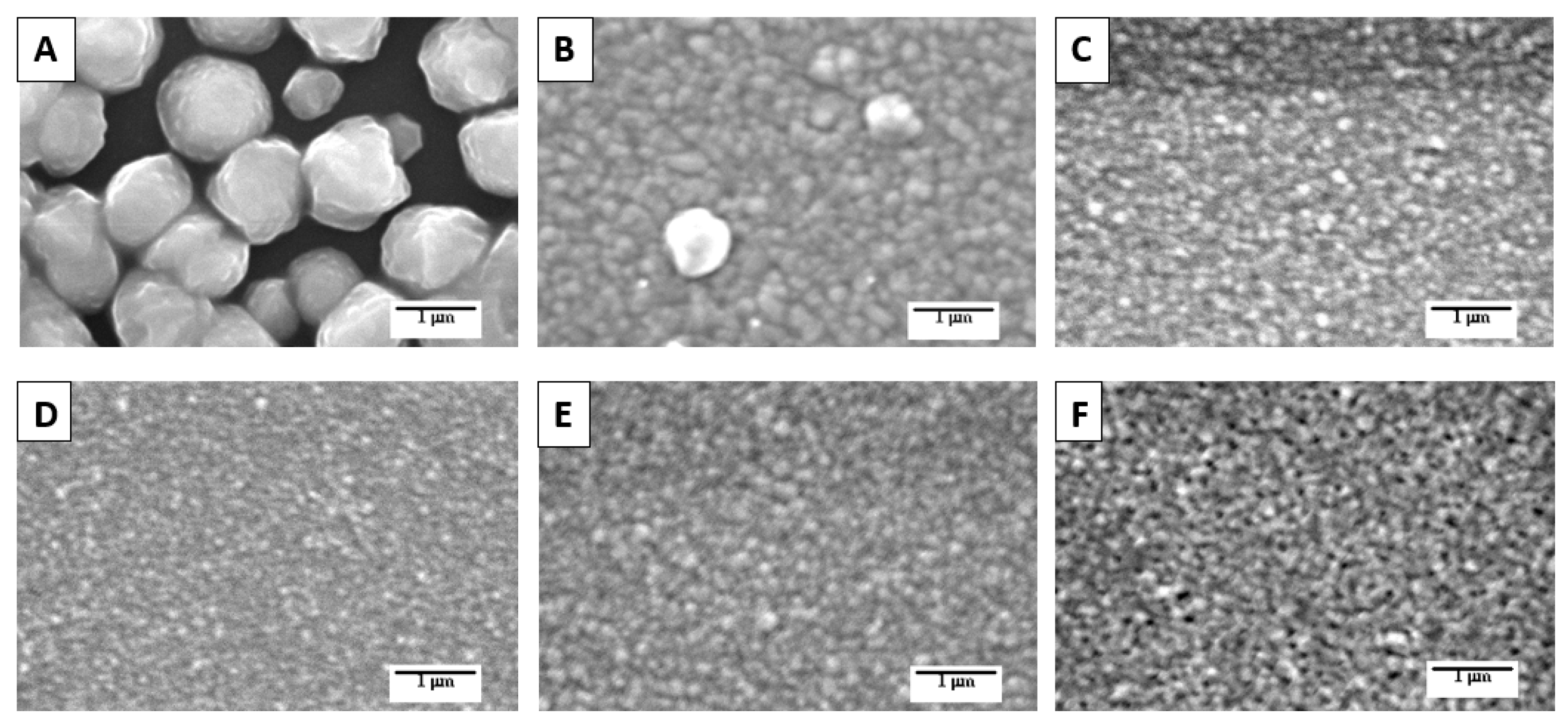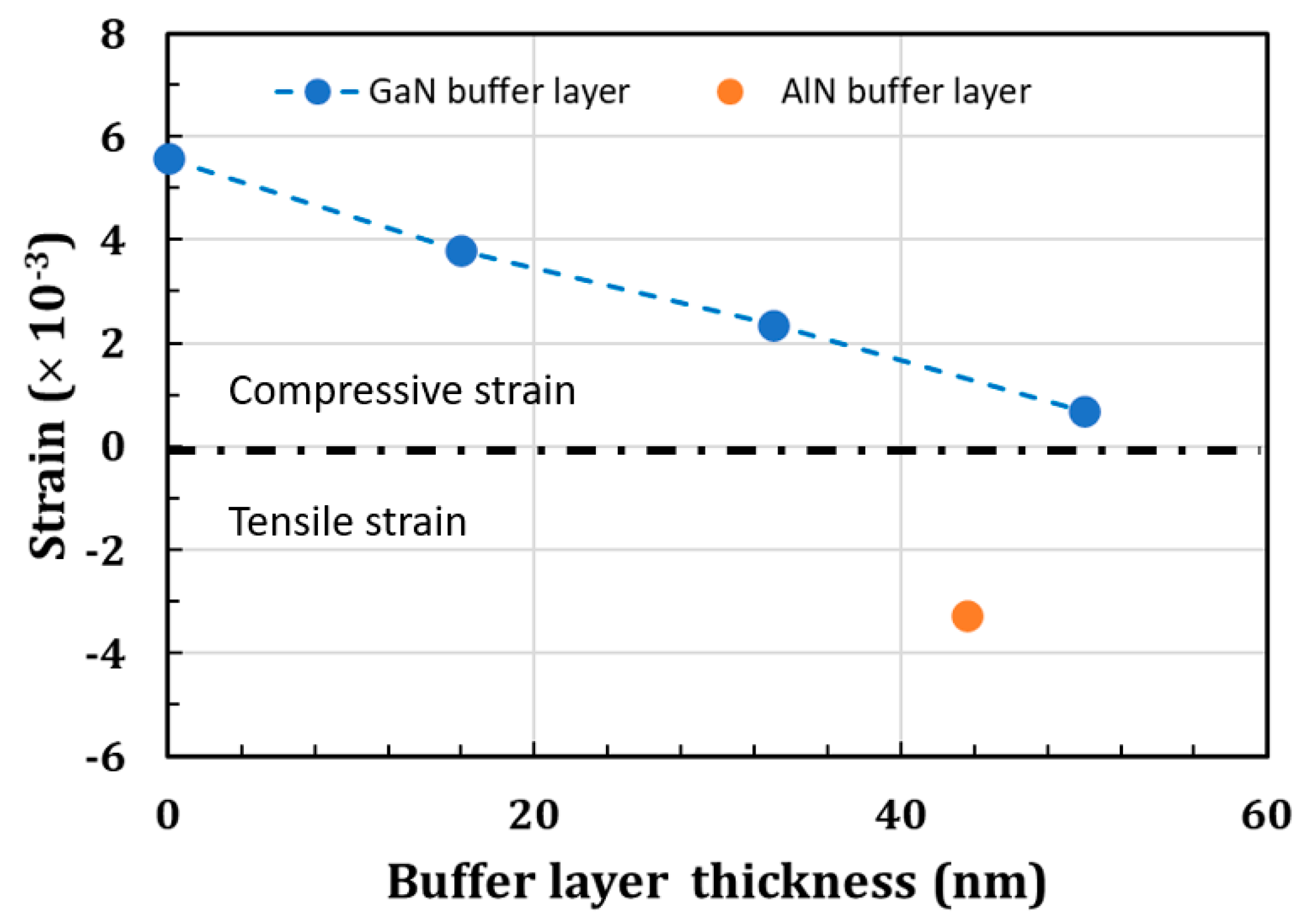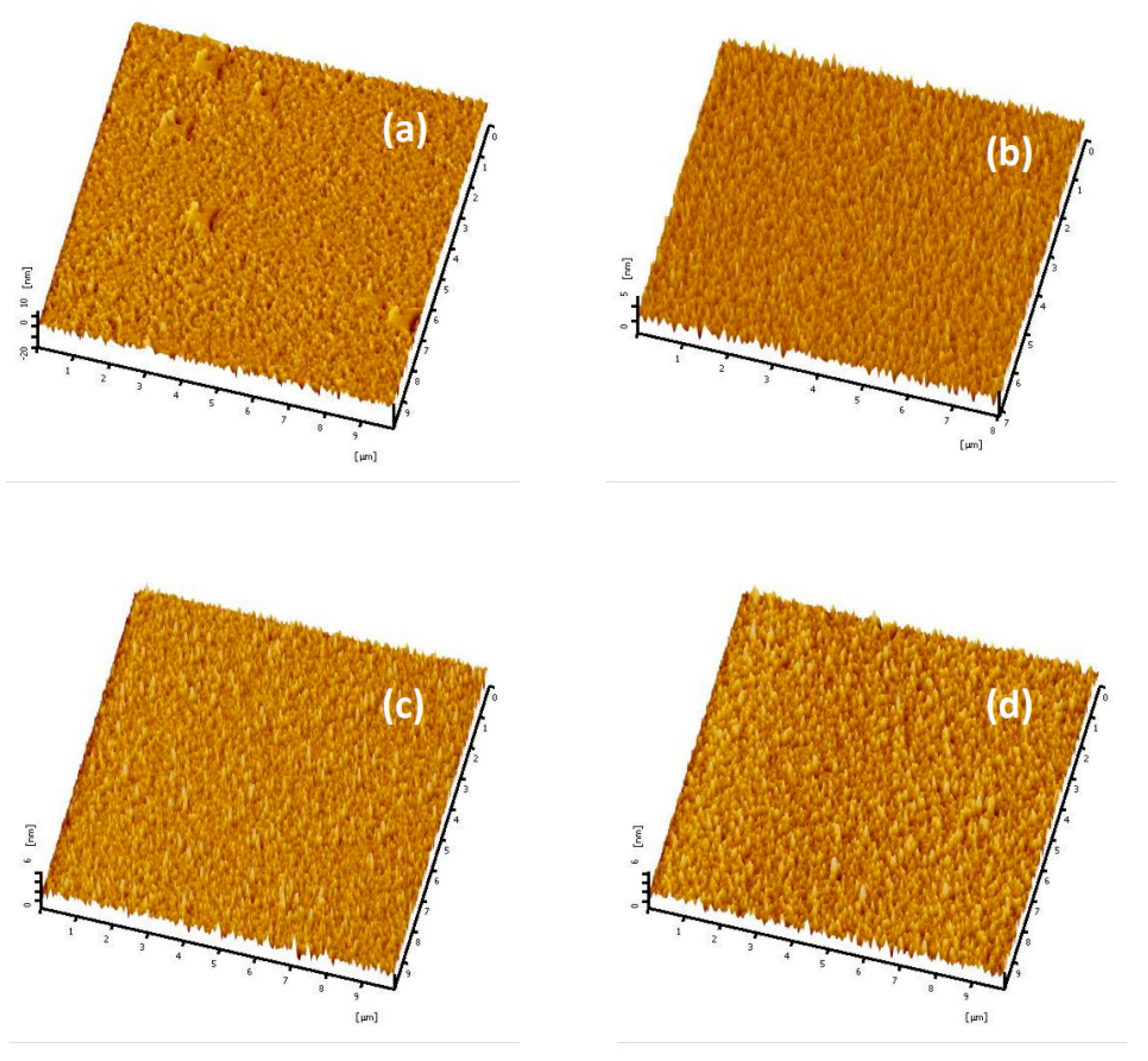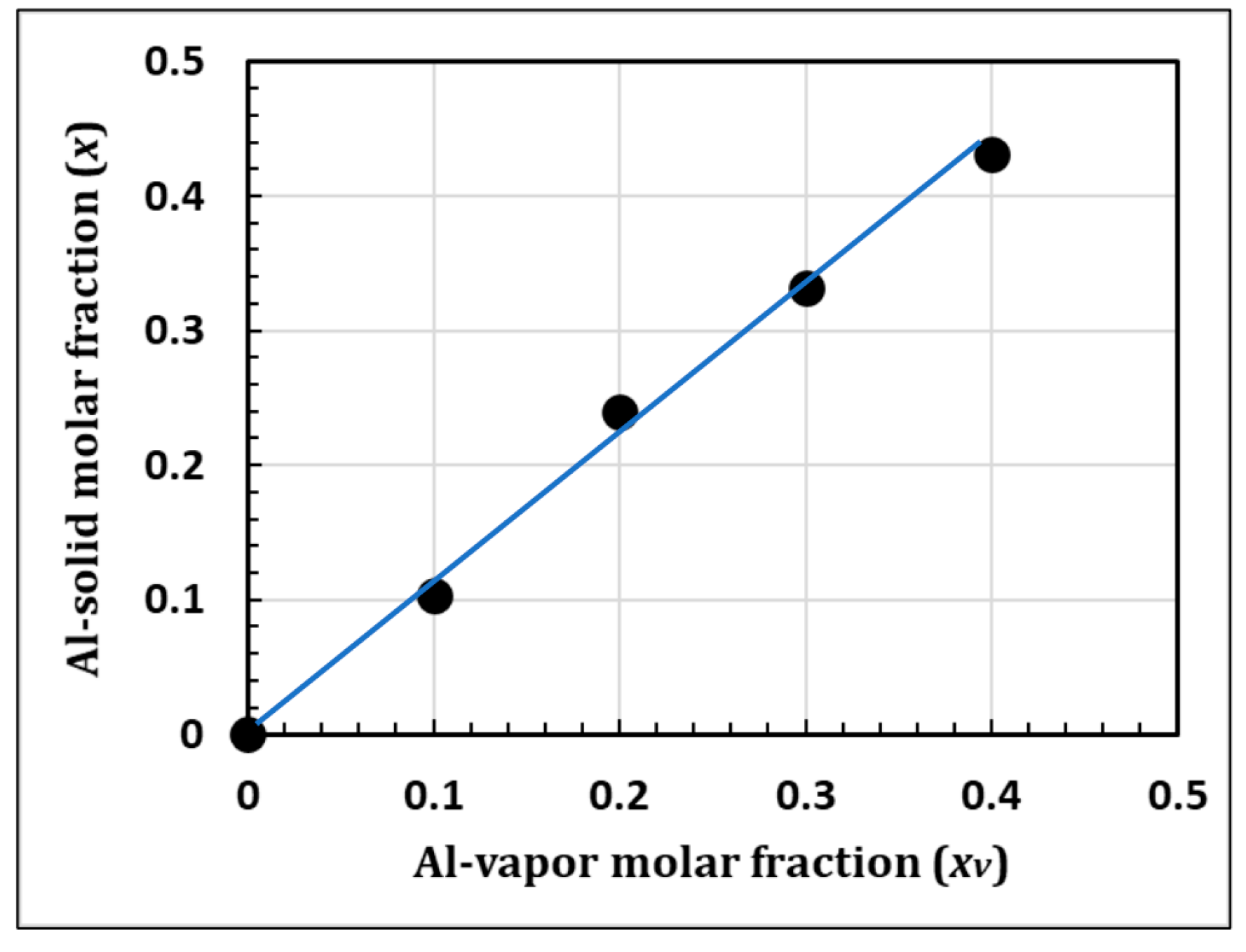Plasma-Assisted MOCVD Growth of Non-Polar GaN and AlGaN on Si(111) Substrates Utilizing GaN-AlN Buffer Layer
Abstract
:1. Introduction
2. Materials and Methods
3. Results
3.1. Growth of GaN
3.2. Growth of AlGaN
4. Conclusions
Author Contributions
Funding
Institutional Review Board Statement
Informed Consent Statement
Data Availability Statement
Acknowledgments
Conflicts of Interest
References
- Wong, M.S.; Nakamura, S.; Denbaars, S.P. Review–Progress in High Performance III-Nitride Micro-Light-Emitting Diodes. ECS J. Solid State Sci. 2020, 9, 015012. [Google Scholar] [CrossRef]
- Wierer, J.J.; Tansu, N.; Fischer, A.J.; Tsao, J.Y. III-nitride quantum dots for ultra-efficient solid-state lighting. Laser Photonics Rev. 2016, 10, 612–622. [Google Scholar] [CrossRef]
- Mishra, U.K.; Shen, L.; Kazior, T.E.; Wu, Y.-F. GaN-Based RF Power Devices and Amplifiers. Proc. IEEE 2008, 96, 287–305. [Google Scholar] [CrossRef]
- Kukushkin, S.A.; Osipov, A.V.; Bessolov, V.N.; Medvedev, B.K.; Nevolin, V.K.; Tcarik, K.A. Substrates for epitaxy of gallium nitride: New materials and techniques. Rev. Adv. Mater. Sci. 2008, 17, 1–32. [Google Scholar]
- Kahouli, A.; Kriouche, N. Estimation of the internal electric field inside (11–22) semipolar GaN/Al0.5Ga0.5N nanostructures and the radiative efficiency at low temperature. J. Appl. Phys. 2014, 115, 193106. [Google Scholar] [CrossRef]
- Ngo, T.H.; Gil, B.; Damilano, B.; Valvin, P.; Courville, A.; de Mierry, P. Photo-induced droop in blue to red light emitting InGaN/GaN single quantum wells structures. J. Appl. Phys. 2017, 122, 063103. [Google Scholar] [CrossRef]
- Wetzel, C.; Zhu, M.; Senawiratne, J.; Detchprohm, T.; Persans, P.D.; Liu, L.; Preble, E.A.; Hanser, D. Light-emitting diode development on polar and non-polar GaN substrates. J. Cryst. Growth 2008, 310, 3987–3991. [Google Scholar] [CrossRef]
- Tanikawa, T.; Rudolph, D.; Hikosaka, T.; Honda, Y.; Yamaguchi, M.; Sawaki, N. Growth of non-polar (1120) GaN on a patterned (110)Si substrate by selective MOVPE. J. Cryst. Growth 2008, 310, 4999–5002. [Google Scholar] [CrossRef]
- Chitnis, A.; Chen, C.; Adivarahan, V.; Shatalov, M.; Kuokstis, E.; Mandavilli, V.; Yang, J.; Khan, M.A. Visible light-emitting diodes using a-plane GaN–InGaN multiple quantum wells over r-plane sapphire. Appl. Phys. Lett. 2004, 84, 3663–3665. [Google Scholar] [CrossRef]
- Craven, M.D.; Lim, S.H.; Wu, F.; Speck, J.S.; DenBaars, S.P. Structural characterization of nonpolar (1120) a-plane GaN thin films grown on (1102) r-plane sapphire. Appl. Phys. Lett. 2002, 81, 469–471. [Google Scholar] [CrossRef]
- Schulze, F.; Dadgar, A.; Bläsing, J.; Hempel, T.; Diez, A.; Christen, J.; Krost, A. Growth of single-domain GaN layers on Si(001) by metalorganic vapor-phase epitaxy. J. Cryst. Growth 2006, 289, 485–488. [Google Scholar] [CrossRef]
- Dadgar, A.; Schulze, F.; Wienecke, M.; Gadanecz, A.; Bläsing, J.; Veit, P.; Hempel, T.; Diea, A.; Christen, J.; Krost, A. Epitaxy of GaN on silicon—impact of symmetry and surface reconstruction. New J. Phys. 2007, 9, 389. [Google Scholar] [CrossRef]
- Zhu, D.; Wallis, D.J.; Humphreys, C.J. Prospects of III-nitride optoelectronics grown on Si. Rep. Prog. Phys. 2013, 76, 106501. [Google Scholar] [CrossRef] [PubMed]
- Wang, K.; Li, M.; Yang, Z.; Wu, J.; Yu, T. Stress control and dislocation reduction in the initial growth of GaN on Si (111) substrates by using a thin GaN transition layer. CrystEngComm 2019, 21, 4792–4797. [Google Scholar] [CrossRef]
- Ma, J.; Zhu, X.; Wong, K.M.; Zou, X.; Lau, K.M. Improved GaN-based LED grown on silicon (111) substrates using stress/dislocation-engineered interlayers. J. Cryt. Growth 2013, 370, 265–268. [Google Scholar] [CrossRef]
- Bolshakov, A.D.; Fedorov, V.V.; Shugurov, K.Y.; Mozharov, A.M.; Sapunov, G.A.; Shtrom, I.V.; Mukhin, M.S.; Uvarov, A.V.; Cirlin, G.E.; Mukhin, I.S. Effects of the surface preparation and buffer layer on the morphology, electronic and optical properties of the GaN nanowires on Si. Nanotechnology 2019, 30, 395602. [Google Scholar] [CrossRef]
- Uen, W.-Y.; Li, Z.-Y.; Huang, Y.-C.; Chen, M.-C.; Yang, T.-N.; Lan, S.-M.; Wu, C.-H.; Hong, H.-F.; Chi, G.-C. Heteroepitaxial growth of GaAs on Si by MOVPE using a-GaAs/a-Si double-buffer layers. J. Cryst. Growth 2006, 295, 103–107. [Google Scholar] [CrossRef]
- Remesh, N.; Chandrasekar, H.; Venugopalrao, A.; Raghavan, S.; Rangarajan, M.; Nath, D.N. Re-engineering transition layers in AlGaN/GaN HEMT on Si for high voltage applications. J. Appl. Phys. 2021, 130, 075702. [Google Scholar] [CrossRef]
- Ni, Y.; He, Z.; Yang, F.; Zhou, D.; Yao, Y.; Zhou, G.; Shen, Z.; Zhong, J.; Zhen, Y.; Wu, Z.; et al. Effect of AlN/GaN superlattice buffer on the strain state in GaN-on-Si(111) system. Jpn. J. Appl. Phys. 2014, 54, 015505. [Google Scholar] [CrossRef]
- Lin, Y.; Yang, M.; Wang, W.; Lin, Z.; Li, G. A low-temperature AlN interlayer to improve the quality of GaN epitaxial films grown on Si substrates. CrystEngComm 2016, 18, 8926–8932. [Google Scholar] [CrossRef]
- Arifin, P.; Sutanto, H.; Subagio, A.; Sugianto, S.; Mustajab, M.A. Optimization of parameters for generating nitrogen plasma in plasma-assisted MOCVD growth of InGaN thin films. AIP Adv. 2019, 9, 115304. [Google Scholar] [CrossRef]
- Weber, Z.L.; Sohn, H.; Newman, N.; Washburn, J. Electron microscopy characterization of GaN films grown by molecular-beam epitaxy on sapphire and SiC. J. Vac. Sci. Technol. B 1995, 13, 1578–1581. [Google Scholar] [CrossRef]
- Chen, P.; Xie, S.Y.; Chen, Z.Z.; Zhou, Y.G.; Shen, B.; Zhang, R.; Zheng, Y.D.; Zhu, J.M.; Wang, M.; Wu, X.S.; et al. Deposition and crystallization of amorphous GaN buffer layers on Si(111) substrates. J. Cryst. Growth 2000, 213, 27–32. [Google Scholar] [CrossRef]
- Naitoh, M.; Shimaya, H.; Watanabe, A.; Nishigaki, S. Hydrogen-induced restructuring and crater formation at Si(111) surfaces: A scanning tunneling microscopy study. Jpn. J. Appl. Phys. 1998, 37, 2033–2034. [Google Scholar] [CrossRef]
- Sawaki, N.; Hikosaka, T.; Koide, N.; Tanaka, S.; Honda, Y.; Yamaguchi, M. Growth and properties of semi-polar GaN on a patterned silicon substrate. J. Cryst. Growth 2009, 311, 2867–2874. [Google Scholar] [CrossRef]
- Ravash, R.; Blaesing, J.; Hempel, T.; Noltemeyer, M.; Dadgar, A.; Christen, J.; Krost, A. Impact of AlN seeding layer growth rate in MOVPE growth of semi-polar gallium nitride structures on high index silicon. Phys. Status Solidi B 2010, 248, 594–599. [Google Scholar] [CrossRef]
- Dreyer, C.E.; Janotti, A.; van de Walle, C.G. Absolute surface energies of polar and nonpolar planes of GaN. Phys. Rev. B 2014, 89, 081305-1–081305-4. [Google Scholar] [CrossRef]
- Suryanarayana, C.; Norton, M.G. X-Ray Diffraction: A Practical Approach; Plenum Press: New York, NY, USA, 1998; pp. 125–135. [Google Scholar]
- Lu, Y.; Liu, X.; Lu, D.-C.; Yuan, H.; Hu, G.; Wang, X.; Wang, Z.; Duan, X. The growth morphologies of GaN layer on Si(111) substrate. J. Cryst. Growth 2003, 247, 91–98. [Google Scholar] [CrossRef]
- Ganchenkova, M.G.; Nieminen, R.M. Nitrogen vacancies as major point defects in gallium nitride. Phys. Rev. Lett. 2006, 96, 196402. [Google Scholar] [CrossRef] [PubMed] [Green Version]
- DenBaars, S.P.; Keller, S. Metalorganic Chemical Vapor Deposition (MOCVD) of Group III Nitrides. In Semiconductor and Semimetal: Gallium Nitride (GaN); Pankove, J.I., Moustakas, T.D., Eds.; Academic Press: San Diego, CA, USA, 1998; Volume 50, pp. 11–35. [Google Scholar]







| Sample | Buffer Layer Thickness (nm) | % At (Ga) | % At (N) | Ga/N Ratio |
|---|---|---|---|---|
| A | Without buffer | 61.45 | 38.55 | 1.59 |
| B | GaN (16 nm) | 62.04 | 37.96 | 1.63 |
| C | GaN (33 nm) | 57.18 | 42.82 | 1.34 |
| D | GaN (50 nm) | 55.92 | 44.08 | 1.27 |
| E | AlN (29 nm) | 63.89 | 36.11 | 1.77 |
| F | AlN (44 nm) | 60.97 | 39.03 | 1.56 |
Publisher’s Note: MDPI stays neutral with regard to jurisdictional claims in published maps and institutional affiliations. |
© 2022 by the authors. Licensee MDPI, Basel, Switzerland. This article is an open access article distributed under the terms and conditions of the Creative Commons Attribution (CC BY) license (https://creativecommons.org/licenses/by/4.0/).
Share and Cite
Arifin, P.; Sutanto, H.; Sugianto; Subagio, A. Plasma-Assisted MOCVD Growth of Non-Polar GaN and AlGaN on Si(111) Substrates Utilizing GaN-AlN Buffer Layer. Coatings 2022, 12, 94. https://doi.org/10.3390/coatings12010094
Arifin P, Sutanto H, Sugianto, Subagio A. Plasma-Assisted MOCVD Growth of Non-Polar GaN and AlGaN on Si(111) Substrates Utilizing GaN-AlN Buffer Layer. Coatings. 2022; 12(1):94. https://doi.org/10.3390/coatings12010094
Chicago/Turabian StyleArifin, Pepen, Heri Sutanto, Sugianto, and Agus Subagio. 2022. "Plasma-Assisted MOCVD Growth of Non-Polar GaN and AlGaN on Si(111) Substrates Utilizing GaN-AlN Buffer Layer" Coatings 12, no. 1: 94. https://doi.org/10.3390/coatings12010094






